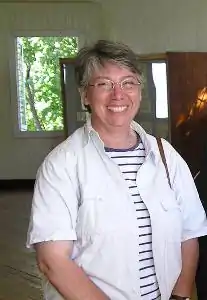Brigitte Senut
Brigitte Senut (27 January 1954, Paris) is a French paleoprimatologist and paleoanthropologist and a professor at the National Museum of Natural History, Paris. She is a specialist in the evolution of great apes and humans.
Brigitte Senut | |
|---|---|
 Senut in 2009 | |
| Born | 27 January 1954 Paris, France |
| Nationality | French |
| Alma mater | Pierre-et-Marie-Curie University Muséum National d'Histoire naturelle |
| Occupation(s) | Paleoprimatologist and paleoanthropologist |
| Spouse | Martin Pickford |
Life and work
Senut is a naturalist and geologist by training and began studying human paleontology and paleoprimatology at a young age. She earned her master's degree in geology at the Pierre-et-Marie-Curie University of Paris in 1975, and specialized in vertebrate and human paleontology, obtaining a doctorate (DEA) in 1976 and defended her doctoral dissertation in 1978. She was interested in the function-phylogeny link in her thesis entitled Contribution à l'étude de l'humérus et de ses articulations chez les Hominidés du Plio-Pléistocène (Contribution to the study of the humerus and its joints in Plio-Pleistocene Hominids).[1]
In 1987, Senut obtained her post doctoral habilitation degree to direct research at the National Museum of Natural History, France, under the direction of anthropologist Yves Coppens, with her thesis entitled Le coude des primates hominoïdes: aspects morphologiques, fonctionnels, taxonomiques et évolutifs (The elbow of hominoid primates: morphological, functional, taxonomic and evolutionary aspects).[1]
Senut has been a professor in the Department of Earth History at the National Museum of Natural History, France, since 1986.[1][2]
Excavations
Senut has initiated and led several international cooperation projects in Africa, including sites in Uganda, Kenya, Namibia, South Africa, Angola and Botswana.[1][2] She joined forces with the British researcher Martin Pickford, who became her life partner and with whom she has made several major discoveries. She participated in many discoveries of fossil great apes in Africa: Otavipithecus in Namibia (12 to 13 million years ago (Mya)), Ugandapithecus and Kogolepithecus in Uganda (20 Mya), the oldest great ape found in South Africa (18 Mya), and in 2011 an exceptionally well preserved skull of Proconsul major.[1][3]
In 2000, Senut, Pickford and their team discovered in Kenya 12 fossil fragments of a new species of Hominina, which they named in 2001 Orrorin tugenensis. The fossils were found in three Kenyan localities in the Tugen Hills (Baringo district), in the Lukeino formation. They are dated to about 5.9 Mya and thus represent the second oldest hominina known to date, after Sahelanthropus tchadensis.[3]
She also helped establish a local community museum at Kipsaraman, Kenya.[1]
Awards
- Broca Medal from the Paris Anthropology Society, 1988.[1]
- Winner of the Nathalie Demassieux Prize (Science) 1988 from the Chancellery of the Universities of Paris.[1]
- CNRS silver medal, 2000[2]
- Knight in the National Order of Merit (Research) 2002[1]
- Knight in the National Order of the Legion of Honor (category Research, 2008).[4]
- Irène-Joliot-Curie prize for woman scientist of the year in 2008.[1][5]
- Cino Del Duca scientific prize In 2019 from the Simone and Cino Del Duca Foundation, becoming the third woman to receive it.
Selected publications
Senut has authored more than 240 original scientific publications.[1]
- Yves Coppens, Brigitte Senut, Origins of bipedalism in hominids, CNRS editions, September 1998
- Herbert Thomas, Brigitte Senut, Primates, ancestors of man, Éditions Artcom, 1999
- Michel Devillers, Brigitte Senut, And the monkey stood up... African adventures of a paleontologist, Albin Michel, October 2008
- Brigitte Senut, The Great Apes, Vuibert, February 2009
- Anna Alter, Brigitte Senut, Who are our ancestors? Great ape, man, what we don't know yet..., publisher Le Pommier, June 2015
Filmography
- Brigitte Senut, the Fossil Hunting Lady, documentary film by Philippe Ayme, 2012, with Senut playing herself.[6]
Abbreviation (zoology)
The abbreviation Senut is used to indicate Brigitte Senut as an authority on description and taxonomy in zoology.
References
- "Brigitte Senut - paléontologue - Biographie - Bibliographie - Hominidés". www.hominides.com. Retrieved 2022-04-04.
- "Brigitte Senut | CNRS". www.cnrs.fr (in French). Retrieved 2022-04-04.
- "Brigitte Senut, la fièvre des fossiles !". France Culture (in French). Retrieved 2022-04-04.
- "Decree of 11 July 2008 on promotion and appointment, Legion of Honor". www.legifrance.gouv.fr. Retrieved 2022-04-04.
- "Irène-Joliot-Curie prize -- Fondation d'entreprise EADS, mécène scientifique - Recherche-fondamen…". archive.ph (in French). 2012-07-31. Archived from the original on 2012-07-31. Retrieved 2022-04-04.
- Brigitte Senut, the Fossil Hunting Lady at IMDb